By Kim McDarison
Cattail abatement will soon be slated as a next step in the city of Whitewater’s Cravath and Trippe lakes restoration project.
According to Whitewater City Manager John Weidl and Whitewater Parks and Recreation Director Eric Boettcher, the city plans to apply to the Wisconsin Department of Natural Resources (DNR) for two permits, one for each lake, to clear cattails along designated portions of shoreline.
The work is anticipated to begin late May or early June, both city official said.
The public was last updated about the project in October, during a public meeting led by Weidl, Boettcher and DNR biologist Heidi Bunk.
An earlier story about the update held in October is here: https://fortatkinsononline.com/whitewater-city-dnr-share-continued-restoration-plans-for-trippe-cravath-lakes/.
A project, focused on the restoration of both lakes, began in 2019. Some $1.5 million in costs to date have been associated with the project.
City officials told Fort Atkinson Online recently that the restoration process is nearly 80% complete, with a final phase, which could take as many as two to three years to complete, focusing on removing some shoreline cattails.
Once permits are obtained from the DNR, both officials said, a designated swath of shoreline, which could be up to 40-feet wide, with a length along each lake’s shoreline that is yet to be determined, is anticipated to take place this spring, and possibly again in 2024, and 2025.
An estimated cost to remove cattails this year is $50,000.
Following the removal of cattails, as authorized by the DNR, the city will enter into a lake maintenance phase, which could begin as earlier as 2024, Weidl said.
According to Boettcher, weather hindered the city’s winter plans to burn some vegetation on top of lake ice.
“We had that arranged with a contractor to come in, and unfortunately, this winter was very mild, so they never had the thickness of ice we needed, and then when we did have some nice cold weather, then we had a ton of snow, which added more moisture, so we made every attempt, but it was never possible due to other conditions,” Boettcher said.
“It needs to be cold, and we need to have an absence of accumulation and projected accumulation,” Weidl said.
The purpose of burning vegetation above the ice was to reduce the amount of debris left behind after plants died off, Boettcher said, adding that as the lake’s water levels rose last year, cattails were anticipated to naturally expire.
Cattails along the shorelines of the lakes were in 2 to 4 feet of water, he said, noting that the plants can’t survive in water that deep.
“So they will die off. When they die off, we wanted to eliminate the debris from the die-off,” Boettcher said.
“What’s happening with the water rising — this is all projected to happen, and part of this is out of our control — the higher the water level rises this year, the better it is for people who would prefer less cattails,” Weidl said.
How many cattails the city can remove this year is determined by the DNR, he added.
Permits will allow the city to cut cattails in “a very specific area,” he said.
Boettcher said the city will be requesting permits to remove cattails from shoreline areas in front of the city’s parks, adding that one permit would focus on an area in front of Cravath Lakefront Park and a second would focus on an area in front of Trippe Park and the Clay Street Nature Park.
To date, he said, he has requested quotes from contractors who can do the work. Once the quote are available, the city will make its request and initiate the permitting process.
A “Cattail cutting and removal update” has been placed on the Whitewater Common Council’s next meeting agenda, scheduled for Tuesday.
Weidl said the removal of cattails became a city focus after the public update held last October.
During that meeting, he said: “The number one thing that came up was focusing on cattails in public areas.”
Boettcher said that the city has the ability to apply for permits that affect properties it owns.
“I can do our property, and in front of our park areas, because those permits follow the landowner,” Boettcher stated, adding that the DNR determines for each permitted property how far along the shoreline a 30- to 40-foot “pathway” can be cut.
Boettcher noted that while earlier in the project, the city considered a chemical treatment as a tool for weed abatement, the process was never used.
‘We are all about filling the lake’
Chemical treatment is only an option when the lakes are drained, Weidl said, which, he added, “would not happen anytime in the near future.
“We are all about filling the lake.”
He added that a consistently high water level will bring the result regarding cattails that he believes most residents are hoping to see.
Weidl said this year, plans call for the lakes to continue to fill with water, and for the city to make a plan to manage species as indicated by the DNR. Once permits are secured and cutting takes place this year, the next step would involve a period he described as “wait and see,” the results of which would determine steps that might need to be taken in 2024 and 2025.
Boettcher said he anticipated a visit will be made to the lakes by Bunk sometime before June.
“A lot of this is also kind of waiting to see what’s going to happen, because we’re not sure how much is going to die off and how much will stay. So it’s an ongoing process to make sure that the future plans we have are eliminating issues we are seeing as they happen,” he stated.
Building water depth, clarity
Boettcher and Weidl both pointed to the importance of the navigation channels which were created by the city’s dredging project, which began in 2021 and and completed in March of 2022.
Navigation channels keep water moving through the lakes, which, in turn, keeps sediment from building on the lake beds, Boettcher said.
The channels are meant to keep the lakes from losing depth, Weidl said, adding “It’s working.”
Both the city and the DNR will continue to verify that result, Weidl added.
“All of our initial visual inspections of what’s happening demonstrates that its working, and it’s more than the lake maintaining its depth, and the DNR will certainly be able to talk about that when they get here.
“The sediment is washing out. If you go to the exit points, it’s happening like it’s supposed to. Not withstanding, I understand people are frustrated with the cattails,” he said.
Boettcher said plans called for the navigation channels in each lake to maintain a depth of five or six feet.
Weidl said a goal is to maintain that target depth “for as long as possible.”
Boettcher said the project also has worked to restore lake health.
“We gained water clarity through this project, a cleaner lake, and a more recreational use lake that has a navigation channel that you can actually paddle, canoe or take a smaller fishing boat in,” he said, adding that last fall, he was able to travel by boat across the lakes as far as Highway 12.
“We were never able to do that before this project. You had water clarity five to six feet down,” he noted.
Before the city undertook the restoration project, Boettcher said the waterway was overgrown with vegetation.
“And that’s probably another reason why DNR won’t allow us to get rid of all the cattails is because cattails actually help take up some of that nutrition, otherwise if you didn’t have those, you would have overgrowing plants again in the lake,” he said.
Fish, waterfowl, recreation
As water levels rise, fish have been returned to the lakes, Boettcher said.
Some have returned naturally by swimming into the waterbodies, which are fed by both Whitewater and Spring Brook creeks.
In addition, Boettcher noted, the city has restocked perch.
“The DNR stocked northern (pike). We don’t stock the bigger fish. The DNR actually stocks the bigger fish. We do more of the bluegill, crappie and then some feeder fish,” he said.
Plans call for the city to continue to restock fish each fall over the next few years, he said.
“It’s just a ramp up for now, for the next year or two, and then we will see what happens,” he added.
Carp eradication was not performed in the lakes.
“It’s an open-water system, so as soon as you remove them, they just come in from upstream. When we looked at removing carp, they (DNR) said we could remove carp, but it was not worth the money because they would be back in six months,” Boettcher said.
A waterfowl management system also will be returning to the lakes, Boettcher said.
“Before the drawdown, we had a hunting program, and that will be coming back this fall. So the city gives out permits to residents who want to hunt on Trippe and Cravath lakes. They can hunt waterfowl,” he noted.
Boettcher said the city offers a limited number of permits that can be used during the DNR’s waterfowl hunting seasons.
A list of hunting seasons for migratory birds, as found on the DNR’s website it here: https://dnr.wisconsin.gov/topic/hunt/dates.
Those interested in obtaining a permit are encouraged to contact Boettcher.
With continued restoration, both officials said, the lake will better suit its intended no-wake recreational use.
Project history, looking ahead
Boettcher, during his presentation offered last fall, noted that the lake projects began July 8, 2019, with Cravath Lake having been drawn down fully after the first season. Siphons added over the spillway in the summer of 2020 enabled the continuous drawdown of Trippe Lake during the following year. Both drawdowns were complete in August 2021. Dredging took place between Jan. 12 and Feb. 27, 2022.
Both lakes were refilled last spring, he said, adding that by the end of August, the lakes were close to being refilled, however, a statewide drought last summer kept the water levels a little below normal.
Weidl described the project as a multiyear journey which is nearing its completion.
“We have to finalize a strategy with the DNR for vegetation management and we have to continue on a path for restocking, and both of those, we knew, were going to take more than one year. We are in year one of something that is going to take either two or three years,” he said, noting that the lakes, after the cattail abatement takes place and maintenance plans commence, will resemble the “version of success that we are going to have at that point in time.”
By the end of 2025, he said, he believed the lakes will closely resemble what most people hoped would be achieved.
“I understand where people want to end up. We are going to continue trying to get there with them. The DNR, they are truly not trying to be a road block. They want what we want, which is a waterway, a navigable waterway, first of all, that’s an important word, a navigable waterway, that is biologically healthy and can be used recreationally for the community. And we want that to be able to last for a significant amount of time.”
Financially, he said, with 80% of the project completed, expenses would no longer be in the hundreds of thousands, but more likely in the tens of thousands, followed by annual maintenance amounts of between $15,000 and $20,000, which, he said, the city has included in its budgeting process.
Said Weidl: “The lake has had an annual maintenance budget for years. It will continue to have it. What I will suggest is that probably what it’s been used for is going to change. Instead of trying to deal with vegetation growth, which was becoming a challenge, we are hoping that’s done and we can change that to cattail management … but that’s generally the path we are on. We have a maintenance budget and it just needs to shift over the next couple of years towards whatever the new goals are.”
Weidl said there was a good likelihood that the lakes would one day require maintenance in the form of dredging.
“I’m hoping that’s a 20-year horizon. It’s going to come down to maintenance. My guess is we will start tracking annually depth changes and we are going to have several year’s warning,” he said, adding that a plan would be to “not let things get out of hand,” focusing on “smaller reconstruction projects,” and “making sure we are investing more time consistently, so you try and avoid the giant lump sum expense.”
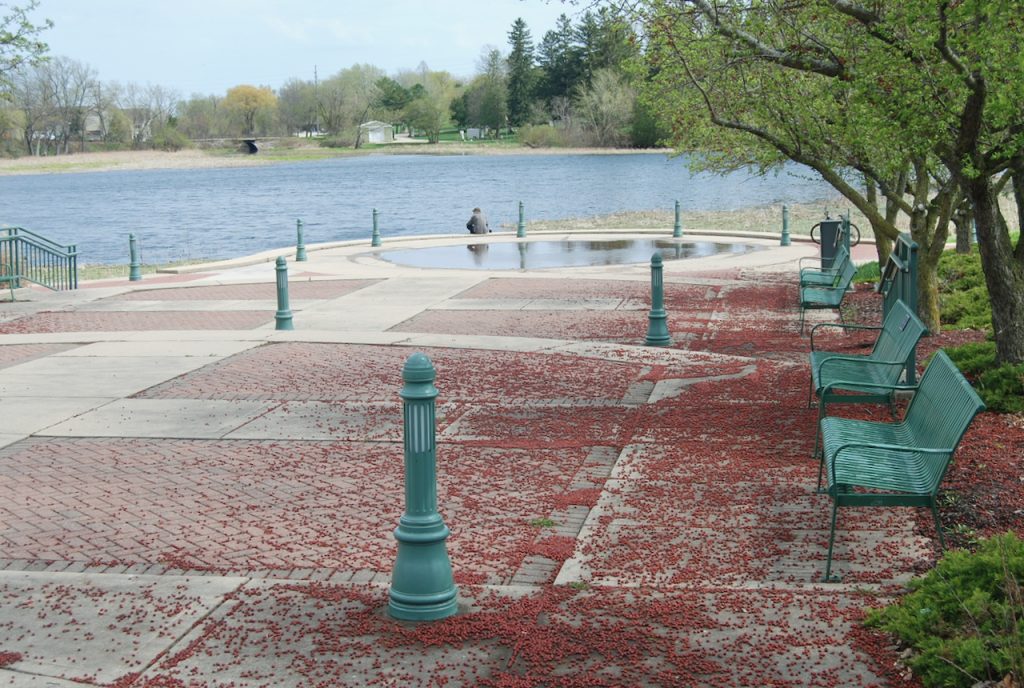
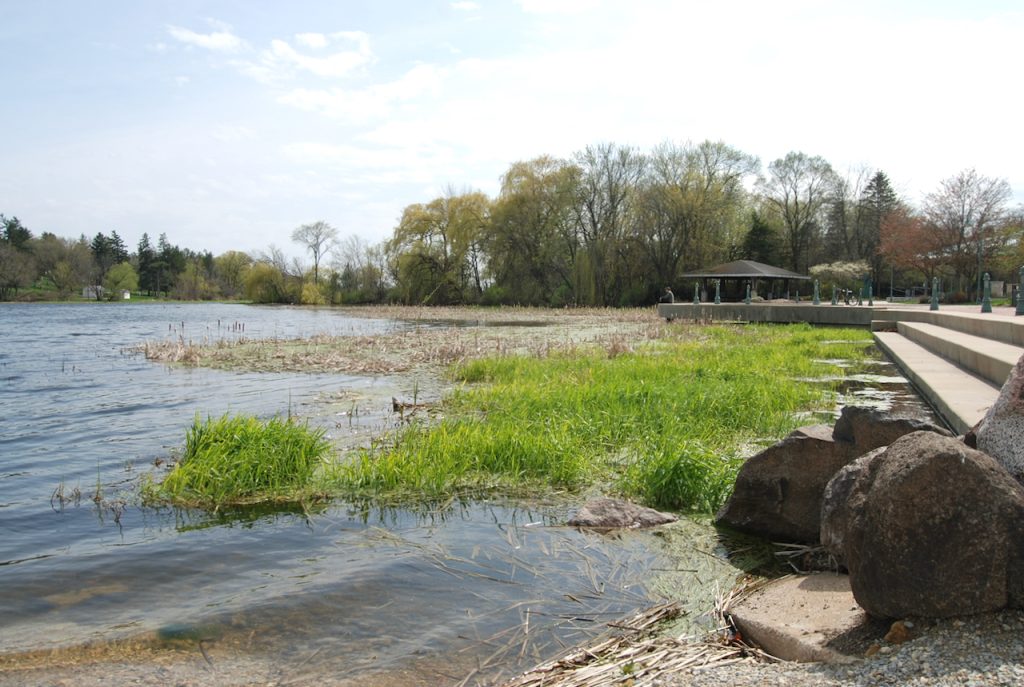
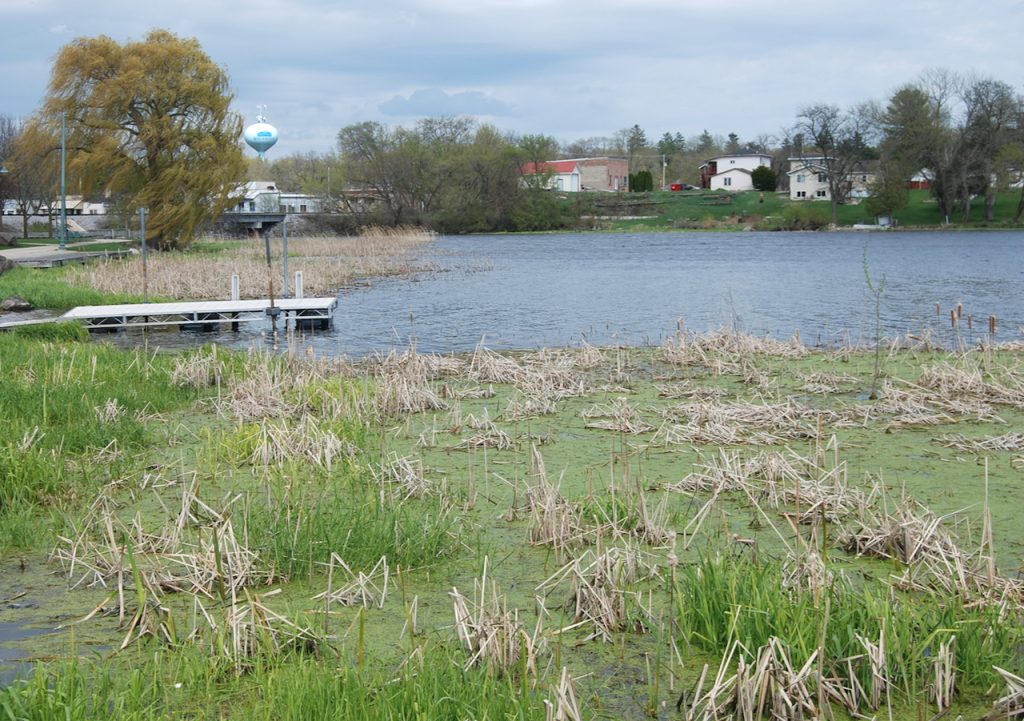
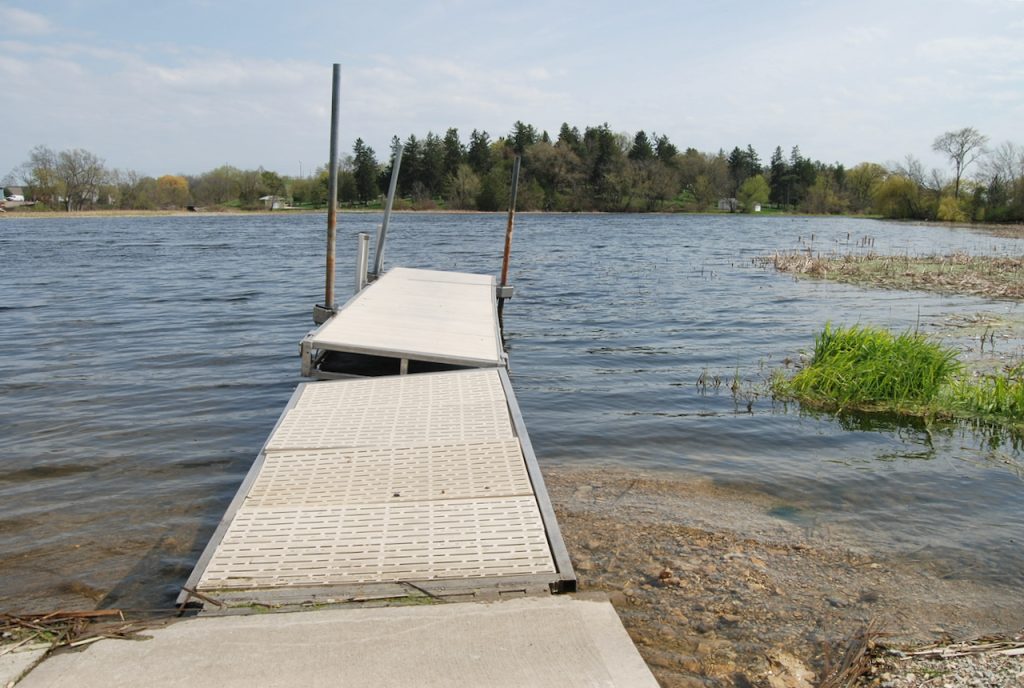
Four photos above: Various views of Cravath Lake from the shoreline in Cravath Lakefront Park show water levels are rising. City officials say cattail abatement is the next step associated with the multiyear lake restoration process. A permit to cut cattails along a yet to be determined portion of shoreline on both Cravath and Trippe lakes is anticipated to be executed sometime in May or June. Kim McDarison photos.

An ornamental concrete shoreline denotes where Whitewater’s downtown Cravath Lakefront Park once met with the water of Cravath Lake. A sea of seven-foot-tall plants engulfed the promenade in September of 2021. File photo/Kim McDarison.
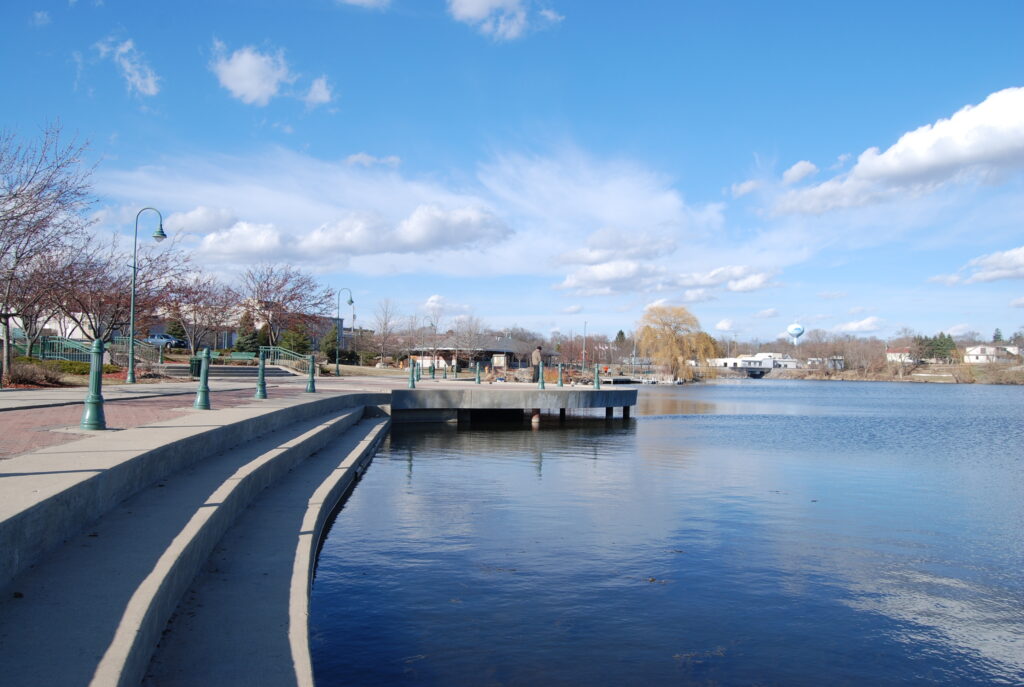
A view of Cravath Lake in the spring of 2015. Planning for a multiyear lake restoration project began in 2017, with restoration beginning in 2019. File photo/Kim McDarison.
This post has already been read 2707 times!
